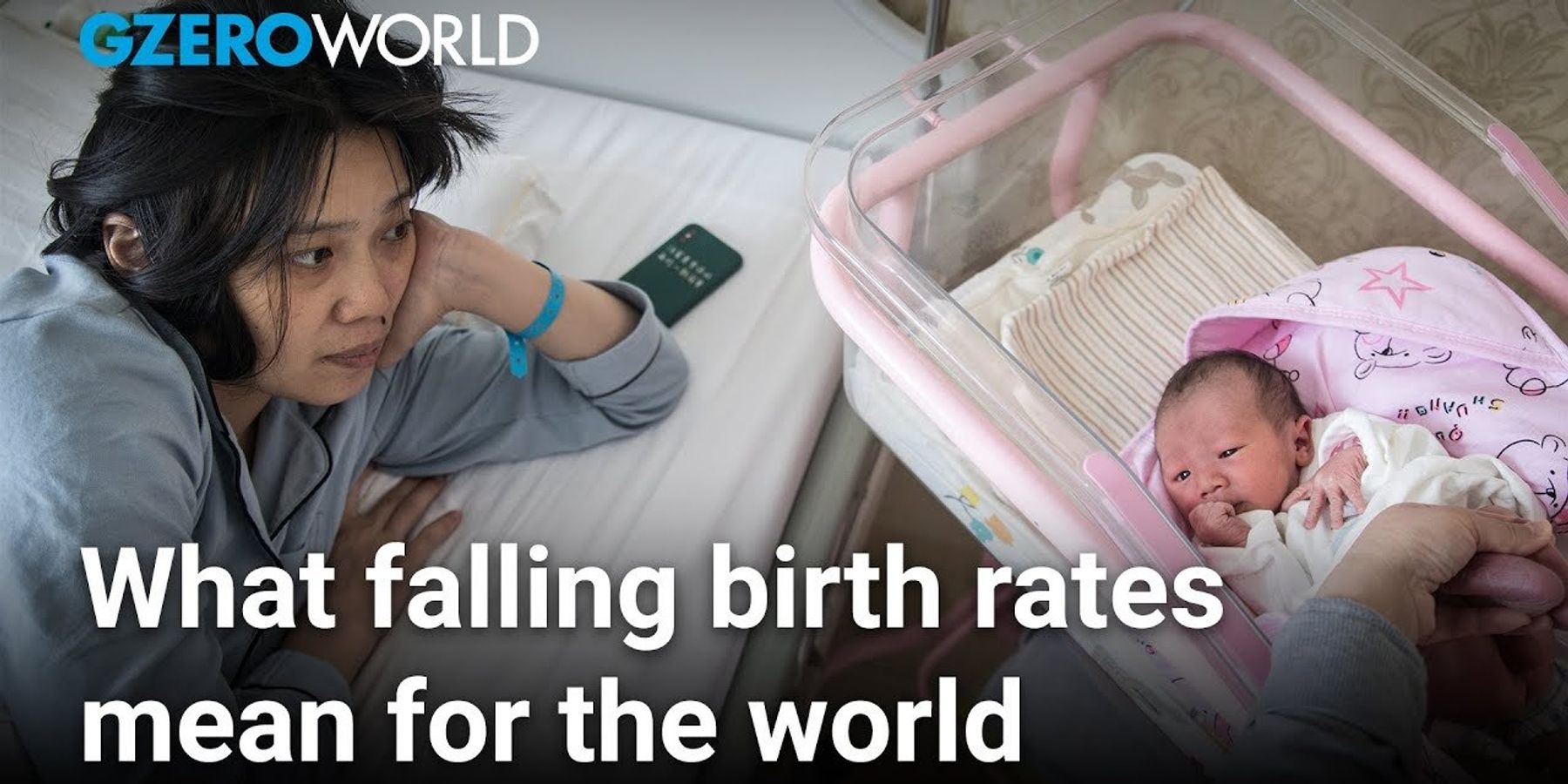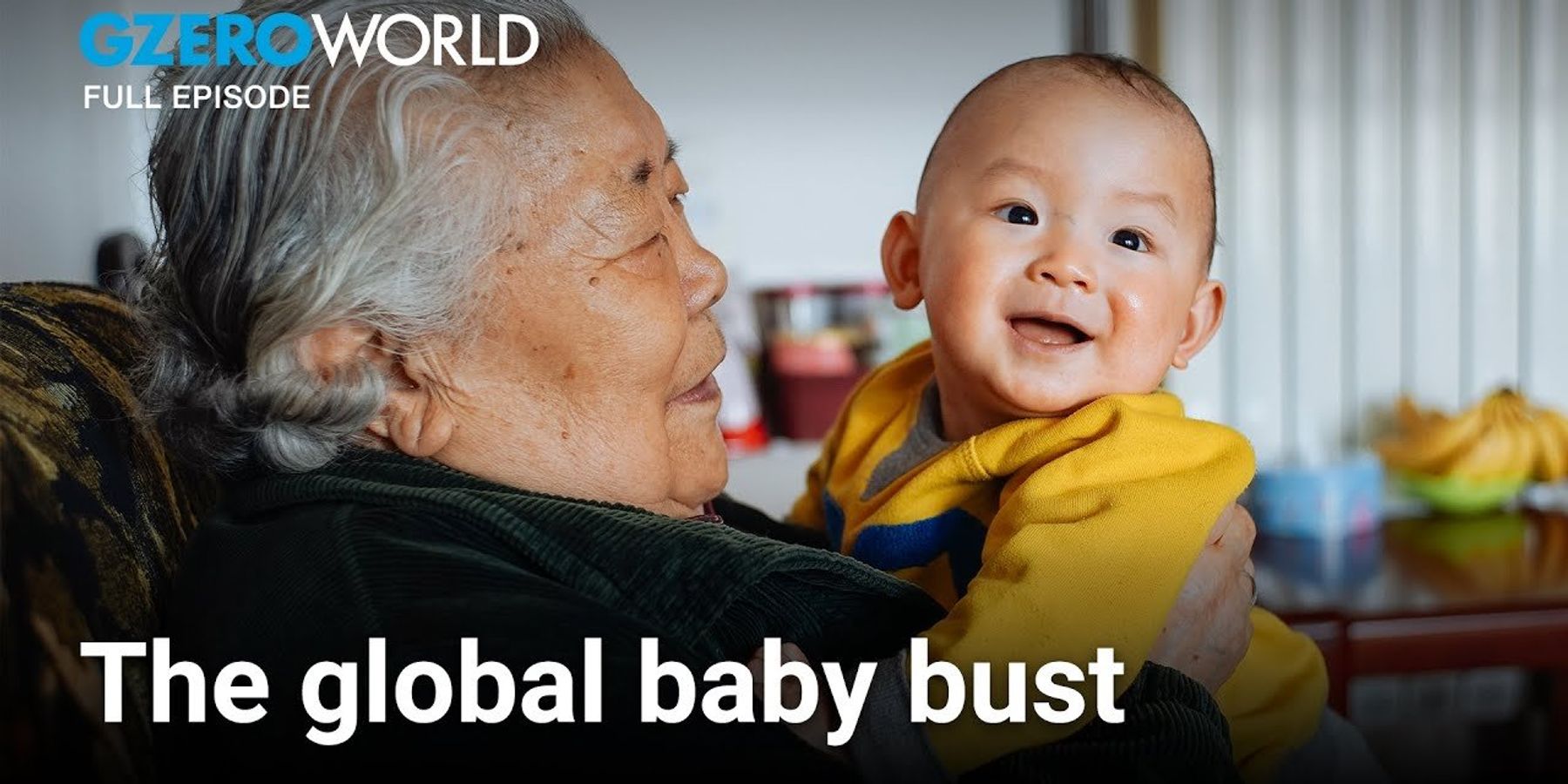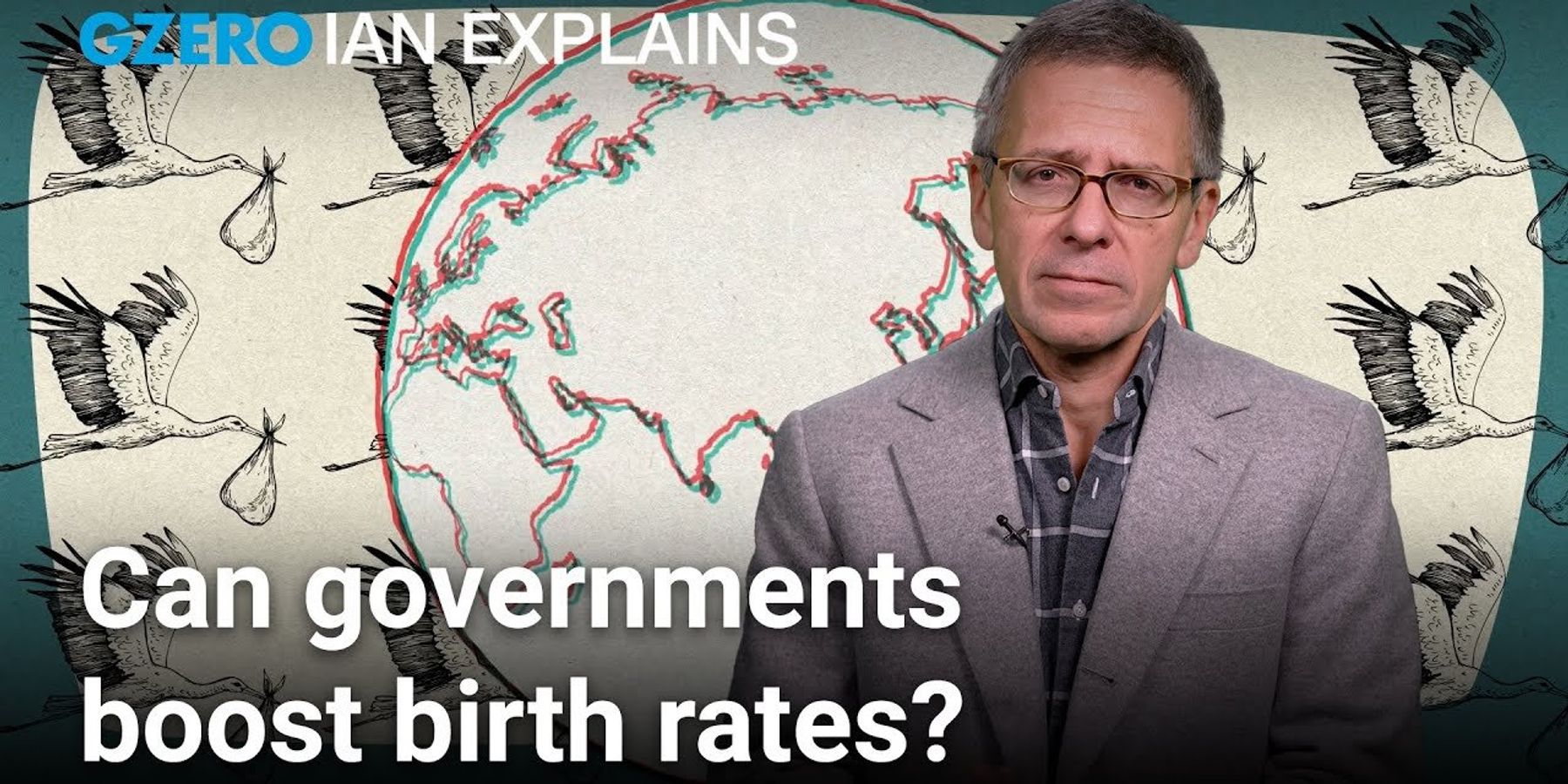Trending Now
We have updated our Privacy Policy and Terms of Use for Eurasia Group and its affiliates, including GZERO Media, to clarify the types of data we collect, how we collect it, how we use data and with whom we share data. By using our website you consent to our Terms and Conditions and Privacy Policy, including the transfer of your personal data to the United States from your country of residence, and our use of cookies described in our Cookie Policy.
{{ subpage.title }}
Should we be worried about population decline?
How worried should we be about falling birth rates around the world? For years, experts have been sounding the alarm about overpopulation and the strain on global resources, so why is population decline necessarily a bad thing? On GZERO World with Ian Bremmer, demographic expert Jennifer Sciubba, President & CEO of the Population Reference Bureau, warns governments are “decades behind” in preparing for a future that’s certain to come: one where the global population starts decreasing and societies, on average, are much older.
Sciubba says that government policies are too focused on trying to get people to have more babies instead of adjusting their social and economic systems for an aging, smaller population. “If we're thinking geopolitically, who's likely to come out on top,” Sciubba predicts, “It'll be the countries who realize the fastest that they're not going to reverse these population trends and they instead build to deal with it.”
Watch full episode: Why the world is facing a population crisis
GZERO World with Ian Bremmer, the award-winning weekly global affairs series, airs nationwide on US public television stations (check local listings).
New digital episodes of GZERO World are released every Monday on YouTube. Don't miss an episode: subscribe to GZERO's YouTube channel and turn on notifications (🔔).
- Hard Numbers: Election violence in Mexico, Baby deficit in Korea, tactical nuke leak in Russia, A gigantic disappearance in the Pacific, Gaza's bleak milestone ›
- Demography and destiny: blessing or time bomb? ›
- China has a big population problem ›
- Why is Xi Jinping lurking in bedrooms? ›
- Will Japan grow its population before it's too late? ›
Why the world is facing a population crisis
How worried should we be about population collapse? Two-thirds of the people on Earth live in countries with fertility rates below replacement levels of 2.1 children per woman. Experts warn the global population will start falling within 60 years, dramatically impacting the future of work and social security. In the US, Vice President-Elect JD Vance has repeatedly expressed alarm over falling birth rates. Elon Musk has called population decline “a much bigger risk” to civilization than global warming. Places like Japan and Italy are already grappling with shrinking workforces, skyrocketing retirement costs, and healthcare systems stretched to their limits. So, we are heading toward demographic catastrophe, and can governments do anything about it? On GZERO World, Ian Bremmer sits with Jennifer Sciubba, president and CEO of the Population Reference Bureau, to discuss population decline, the global fertility crisis, and why now is the time to reorient our economic and social welfare systems for an aging future.
“The governments that do not adjust their systems to deal with what you actually have, which is an aging smaller population in the future,” Sciubba warns, “They will have a problem."
GZERO World with Ian Bremmer, the award-winning weekly global affairs series, airs nationwide on US public television stations (check local listings).
New digital episodes of GZERO World are released every Monday on YouTube. Don't miss an episode: subscribe to GZERO's YouTube channel and turn on notifications (🔔).
Should we rethink the global aging crisis?
The world is quietly being reshaped by a demographic time bomb: Birthrates are plummeting, and the global population is rapidly aging. By 2050, one in six people will be over 65. While the overall population is still increasing—driven by growth in developing countries like Nigeria and Pakistan—experts predict it will peak in about 60 years. The shift to depopulation will have huge implications for the future of work, healthcare, and retirement. So what can we do about it? On Ian Explains, Ian Bremmer breaks down the different strategies governments are using to try to get people to have more kids, particularly in East Asia, where the population crisis is severe. Countries like Japan and South Korea have tried tax incentives, expanded parental leave, subsidized child care, and even matchmaking. But nothing is working. Is a slow-moving crisis inevitable? Or, instead of turning back the demographic clock, is it time to start rethinking the future of aging?
GZERO World with Ian Bremmer, the award-winning weekly global affairs series, airs nationwide on US public television stations (check local listings).
New digital episodes of GZERO World are released every Monday on YouTube. Don't miss an episode: subscribe to GZERO's YouTube channel and turn on notifications (🔔).
Graphic Truth: From baby boom to baby gloom
Women are having fewer children in the US and Canada, where birth rates have been falling since the 1960s. In 2020, Canada’s fertility rate hit an all-time low of 1.4 children per woman. In the US, the national birth rate has fallen by 20% since 2007.
The baby bust is not unique to Canada and the US; the decline is unfolding across the OECD, as women gain increased access to contraception, higher education, and careers, all of which tend to lead to delayed family planning.
High inflation in recent years isn’t helping matters. After all, kids are expensive – from housing to education to health care – which may be enough to deter some couples.
But there is one OECD country where this isn’t the case: Israel. Israeli women have an average of 3.1 children, making Israel the only OECD country where the birth rate is above the replacement level. Experts attribute this to the influence of religion and tradition in the country, as well as social and economic policies that encourage work-family balance.Will Japan grow its population before it's too late?
What if a hypothetical government, overtaxed by an aging, shrinking population, decided to ask its seniors to make the ultimate national sacrifice to voluntarily die?
That’s the premise of "Plan 75," a 2022 indie film that predicts a grim dystopian and not-too-distant future for a fictional Japan, where the elderly are offered compensation to submit to euthanasia and avoid being a burden to society when they turn 75.
Sure, it’s just a movie, but nowhere is more at risk of a demographic implosion than Japan. With a median age of 49, it’s the world's oldest country, and 28% of people are 65+. The nation of 125 million — whose annual births dropped below 800,000 for the first time in 2022, eight years earlier than forecasted — is expected to lose almost one-third of its population by 2060.
As its population shrinks, Japan’s government is running out of time. “It is now or never when it comes to policies regarding births and child-rearing,” PM Fumio Kishida said on Monday during a speech in parliament.
For the first time, he’s made reversing Japan’s declining fertility rate (1.38 births per woman) an urgent priority — as time-sensitive as doubling defense spending to counter military threats from China and North Korea.
Indeed, Kishida warned, “our nation is on the cusp of whether it can maintain its societal functions.” Within decades, the GDP of Japan, now the world’s third-largest economy, might contract to the point where it struggles to keep the lights on because it won’t have enough productive workers.
The declining births are a "huge pothole on Japan’s road to economic growth," says David Boling, Eurasia Group’s lead Japan analyst.
"It means Japan has to squeeze more and more productivity out of fewer and fewer people. Technology, artificial intelligence, and robotics can help gain back some of that lost productivity," he explains. "But it can only go so far.”
There are two ways to boost Japan's dismal birth rate from the domestic supply side. First, encourage couples to have more kids by paying them money. Second, support families with further economic benefits like paid parental leave or subsidized childcare. Kishida says he plans to double the national budget for families and create a new government agency to get Japanese to make more babies.
But "it’s not that simple," says Boling. "The government has provided financial incentives in the past and created a cabinet minister for dealing with the low birthrates. But the [births] continue to drop."
Meanwhile, Japanese women are giving birth less because fewer are getting married. Although that’s mostly due to more economic opportunities for them, many are also reluctant to tie the knot due to traditional domestic gender roles that put almost all the burden on women to take care of the house and kids.
There is something else Kishida could do that would actually fix the problem: welcome immigrants with families.
Unfortunately, for decades immigration has been a political taboo in Japan due to centuries of self-imposed isolation and a long-held defense of ethnic homogeneity among the right. Even an acute labor shortage in recent years has only resulted in slight relaxation of one of the world's strictest immigration policies.
"Rapidly increasing immigration would probably be the fastest way to reverse the population decline. But Japan resists that option," says Boling. For Japan to reverse course, he adds, "there must be a sea change in attitude about the benefits of immigrants."
Finally, Japan’s demographic erosion will be closely watched by its two East Asian neighbors, who view it as a cautionary tale they must avoid at all costs. China recently admitted its first population drop since 1961, while South Korea has reported the world’s lowest fertility rate for three years in a row.
If things really go south, would Japan implement Plan 75? Certainly not, but the director wouldn’t be too surprised if it did.
"After the film's release, I encountered the voice of people who strongly desire to have this option because they are afraid of their future living as the elderly," says Chie Hayakawa. "I feel that we Japanese are covered with [such a] sense of resignation and hopelessness [that we] cannot believe or expect our government to bring any solution to it."
- Trump indictment would make GOP nomination more likely - GZERO Media ›
- Scott Galloway on population decline and the secret sauce of US success - GZERO Media ›
- Should we rethink the global aging crisis? - GZERO Media ›
- The global population is aging. Is the world prepared? - GZERO Media ›
- Why the world is facing a population crisis - GZERO Media ›
- Should we be worried about population decline? - GZERO Media ›


